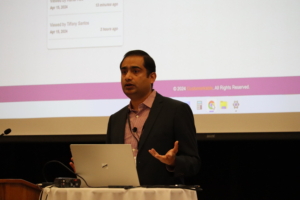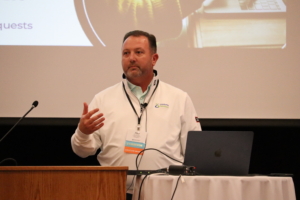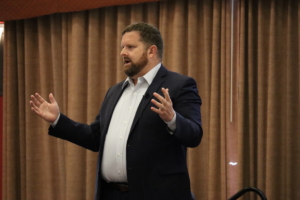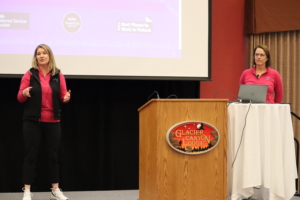The April 2024 WBA Compliance Journal is now available. In this edition, readers will find a summary of recent enacted state legislation. The “regulatory spotlight” section sets forth summaries of recently published agency rules and notices, and the “compliance notes” section provides other important compliance-related updates for bankers.

Charles Potts, ICBA
On April 15, 2024, bankers and FinTech vendors came together for WBA’s second annual FinTech Showcase. The full-day event opened with a keynote session on harnessing the power of artificial intelligence (AI) by Charles Potts, EVP and chief innovation officer at ICBA. Potts covered three important aspects of preparing for an AI-driven future:
- Invest in Training: upskill employees to work alongside AI tools.
- Collaborate with Tech Firms: Partner with AI innovators for best solutions.
- Stay Updated: Keep abreast of the latest AI trends and technologies.
“I now use ChatGPT more than I use Google Search.” – Charles Potts
Throughout the day, attendees had the opportunity to watch eight live FinTech demonstrations (20 minutes each) and network with other bankers and over a dozen FinTech providers in the Showcase Hall. A variety of vendors presented live demonstrations of their products and services:

Brandon Ragan, Alkami; and Cyrene Wilke, Horicon Bank
Alkami Technology, Inc. is a leading cloud-based digital banking solutions provider for financial institutions in the United States that enables clients to grow confidently, adapt quickly, and build thriving digital communities. Alkami helps clients transform through retail and business banking, digital account opening, treasury management, data analytics, and marketing solutions.

Eisley Nkwonta, Array US, Inc.
Array is a leading financial innovation platform that helps financial institutions get compelling consumer products and features to market quickly. Our table stakes products include credit monitoring and identity protection features that improve financial literacy, increase digital engagement with customers, and provide non-interest income opportunities. Banks also have access to Array’s Offers Engine which unlocks hyper-targeted marketing for credit products.

Dave Mancl, Wisconsin Department of Financial Institutions; and Joe Saari, ELEVATE Wisconsin
ELEVATE Wisconsin® is a financial wellness program that provides interactive, effective, unbiased online instruction in personal finance and investing fundamentals designed to enhance the lives of Wisconsin employees and their families. This program was created through public-private collaboration with the Department of Financial Institutions, the Governor’s Council on Financial Literacy, the University of Wisconsin-Madison, and iGrad/Enrich Financial Wellness to help empower and improve the financial literacy of Wisconsinites.

Rahul Rao, EngageGPS
EngageGPS by Customarkable, LLC is a transformative customer engagement and growth platform for community banks that redefines how the financial institution connects with its customers. It’s the next-gen of relationship management solutions that until now has only been available to large regional and national banks.

Lori Shao, Finli, Inc.
Finli helps community banks grow business deposits, attract, retain, and deepen relationships with business customers, and compete effectively against NeoBanks, FinTechs, and large banks. We offer an embedded and turnkey comprehensive digital back office for micro, small, and mid-sized businesses offered through community banks.
KlariVis is the only cloud-based, core-agnostic enterprise dashboard and data analytics platform built for bankers, by bankers. KlariVis helps your entire organization see data clearly, empowering you, your team, and your customers to live and work better.

Paul Lehnert, Lenderful Solutions
Home Equity Turbo by Lenderful Solutions allows a lender to process and close a loan in two days. The solution has built-in automation tools, including AVM, Credit Pull (soft or tri), VOI, VOE, VOA, ID verification, property reports, insurance quotes, and underwriting summaries.

Scott Earwood, White Clay
White Clay is a software solution that helps you build great relationships, know what they are worth, and see them in an actionable dashboard so your bankers can make smarter decisions to drive better returns.
To find additional FinTech providers and other companies that cater to Wisconsin’s banking industry, please visit the WBA Associate Member Directory.
 By Rose Oswald Poels
By Rose Oswald Poels
For banks, promoting financial literacy and capability is a long-standing, year-round tradition. These efforts are especially amplified throughout April, Financial Literacy Month. It is during this time that our industry showcases our ongoing commitment to supporting the financial wellness of our local community members.
With a mission to promote financial literacy and capability to the public and to broaden consumer empowerment in the financial services industry, the Wisconsin Bankers Foundation is proud to partner with banks across the state to aid in the effort to equip individuals of all ages with the knowledge and skills essential for making informed financial choices. In addition to scholarships offered annually to Wisconsin students and research published on Banconomics.com, education remains a significant priority. As such, the Foundation has curated a list of digital resources bankers may leverage in their efforts to promote financial well-being. These resources are free to use in April and throughout the year.
In addition to promoting these efforts in conjunction with your team’s participation in WBA’s Power of Community Week, I ask that your team also complete the Foundation’s 2023–2024 Financial Education Summary Forms to capture and celebrate the numerous ways bankers volunteer their time and expertise to foster financial literacy. While many bankers do not seek recognition for their outstanding service to Wisconsinites, reporting the financial education-focused activities your bank is involved with helps inform the efforts of WBA and WBF staff and is compiled for elected officials and members of our communities to highlight our collective efforts.
As economic uncertainties linger, personal finance and financial stability remain top of mind for communities throughout the country. In Wisconsin, it is evident that bankers remain dedicated to building a stronger and more resilient financial future for all. Thank you for your continued commitment.
In partnership with Employ Milwaukee, the Wisconsin Bankers Association (WBA) is proud to bring the nationwide BankWork$ program to Wisconsin. BankWork$ is a free, eight-week training program to prepare participants — primarily individuals from under-resourced communities — for retail banking careers. Upon graduation, each class then takes part in a hiring event featuring BankWork$ employer partners.
In March, a class of six students — including Yazmin Franco Luna, Timesha Gray, Alesha Hodges, Shatyea Patterson, Mariana Simas, and Chapa Wijendra — graduated from the program. WBA’s Rose Oswald Poels attended the ceremony and congratulated the graduates on their achievement.

Pictured (left to right) are: Adriene Wright, BankWork$ instructor; Alesha Hodges; Timesha Gray; Rose Oswald Poels, WBA president and CEO; Yazmin Franco Luna; Mariana Simas; Chapa Wijendra; and Shatyea Patterson.
Over the course of the eight-week program, students learned the heard and soft skills necessary for entry-level retail and operations positions. Beginning in 2019, the program has now provided over 130 individuals in the Milwaukee area with the opportunity to begin a career in banking.
To learn more about the program, or how your bank can get involved, please visit employmilwaukee.org/BankWorks.htm.
 By Rose Oswald Poels
By Rose Oswald Poels
Last month, over 200 bankers from across Wisconsin convened in Madison for the Wisconsin Bankers Association’s annual Capitol Day. This turnout — the largest in WBA’s advocacy history — attests to our members’ ongoing commitment to speak up on behalf of our industry and advocate for legislation that helps our customers and communities. Many bankers participate throughout the year in making calls, sending letters, and personally contributing to the industry’s political action funds, and your physical presence at events such as Capitol Day plays a crucial role in reinforcing the collective voice of Wisconsin’s banking industry.
The last biennium has resulted in several advocacy accomplishments that would not have been possible without the active participation of WBA-member bankers and the support of elected officials on both sides of the aisle. As we switch gears to what is to come in 2024, including the U.S. election later this year, we must be proactive in maintaining our current success. Recently, each member bank was mailed the annual Advocacy Toolkit. If it has not already arrived, please keep an eye out for it in the coming days. The Toolkit features several resources including best practices, how to identify and contact local legislators, as well as all the ways your bank can choose to assist the Association in our political fundraising efforts.
Although fundraising is not the most endearing aspect of advocacy, it is certainly one of the most important. Monetary support helps the WBA team effectively lobby for key issues impacting the industry and our communities. For this calendar year, WBA hopes to raise at least $300,000 in personal contributions to support the Association’s advocacy efforts. Through the Alliance of Bankers for Wisconsin (ABW) political conduit or Wisbankpac, bankers are able to donate directly to the candidate(s) of their choosing or pool their contributions with other individual bankers to maximize the overall impact in the political process, respectively.
While bankers are welcome and encouraged to join WBA’s Leadership Circle, awarded to those who contribute at least $3,000 to any combination of the ABW or Wisbankpac, it is important to emphasize that even small-dollar contributions help make a big difference. By donating at the Silver Triangle level (at least $1,000), you join a network of dedicated supporters who play a vital role in bolstering the advocacy initiatives that support elected officials who support the banking industry.
If you have any questions regarding political fundraising or would like to learn more about which donation level is right for you, please do not hesitate to reach out to Lorenzo Cruz, WBA vice president – government relations, or me. With so much in store for the upcoming legislative session, I truly appreciate the members who go out of their way to join WBA in our advocacy efforts on behalf of the banking industry.
 By Daryll Lund
By Daryll Lund
Every year, the banking industry becomes increasingly competitive and with new trends, technology, and specialized services emerging at rapid speeds, there is no way for one single business to do it all. The Wisconsin Bankers Association is pleased to offer WBA bank members access to the over 150 vetted, dedicated companies that make up the Association’s Associate Member program.
Made up of a broad spectrum of third-party providers from around the country, WBA’s Associate Members program features companies that specialize in specific products and services related to banks. In forming strong partnerships with third-party vendors, many WBA members have found great benefit directly impacting their bank’s growth to the satisfaction of their customers.
Furthermore, Associate Member companies serve as valuable partners of the Association. From sharing their expertise through resources published in our publications to presenting on hot topics at WBA events, our Associate Members help us create meaningful, relevant content that informs bankers throughout Wisconsin. WBA’s Associate Member program offers just the place for banks to locate whatever niche expertise and product specialization they need to stay ahead in our continuously evolving industry. WBA stands ready to identify companies that seek to assist Wisconsin’s banking industry and connect banks with the vendor(s) that will meet their needs.
To learn more about WBA’s Associate Member program and how your bank can make the most of the resources available, please visit wisbank.com/Associates or contact Nick Loppnow, director – associate membership and business development, at nloppnow@wisbank.com.
The March 2024 WBA Compliance Journal is now available. In this edition, readers will find an article regarding DOR issuing an emergency rule to interpret state commercial loan income exemption. The “regulatory spotlight” section sets forth summaries of recently published agency rules and notices, and the “compliance notes” section provides other important compliance-related updates for bankers.
March 21, 2024, was a busy day in Madison with Governor Tony Evers signing over 50 bills into law, including the following list in order of Act numbers. A full list of the bills signed into law yesterday may be found at: https://www.wsaw.com/2024/03/21/gov-evers-takes-action-over-50-senate-assembly-bills/
Note: Regarding SB 616 (now Act 146), the Department of Revenue has posted an updated form instructions and Common Questions to their website.
Senate Bill 759, now 2023 Wisconsin Act 127:
- Makes several changes related to trusts, including administration, adopting the Uniform Powers of Appointment Act, adopting the Uniform Trust Decanting Act, and creating an exception under the general marital property law allowing digital property to be classified as individual property if certain criteria are met.
Senate Bill 773, now 2023 Wisconsin Act 128:
- Repeals the requirement that financial institutions provide advance notice to the Wisconsin Department of Financial Institutions (DFI) before the acquisition, placement, or operation of off-site ATMs.
- Makes it a Class H felony to intentionally cause impairment or interruption to any ATM or customer bank communications terminal.
- Expands the authority of credit unions to purchase, lease, hold, and convey certain real estate, subject to guidance from the Office of Credit Unions.
- Allows credit unions to issue or offer supplemental forms of capital, in the form and with the conditions specified by DFI. All applications for supplemental capital would have to be approved by DFI in writing and obtained before the issuance of the supplemental capital.
- Requires the board of a credit union to fill a vacancy on its board of directors within 90 days of the position becoming vacant, no matter the cause.
- Extends, from 30 days to 60 days, the time during which the Office of Credit Unions must determine whether an activity or power that becomes authorized for federally chartered credit unions should also be authorized for Wisconsin-chartered credit unions.
- Extends the time credit unions have to pay for their required examinations to 30 days after the completion of the examination.
- Removes the restriction on savings and loan associations that require all the loans they provide to be within a 100-mile radius of their office.
- Eliminates disclosure requirements that require lenders to notify a residential mortgage borrower in writing of: (a) the reason(s) for an adverse action on an application (unless a notice as required under federal law is delivered); (b) whether an application fee is refundable; (c) whether the interest rate and other terms of the agreement may change before the closing date; and (d) if the loan servicing for the residential mortgage is sold.
- Repeals certain disclosures required of lenders related to variable rate loans, including disclosure of the index used and its current base and the rights of a borrower concerning a change in the interest rate.
- Extends the maximum maturity date of a promissory note issued by a municipality, county, or school district from 10 years to 20 years.
- Increases, from $400,000 to $1,000,000, the maximum amount of compensation DFI can provide to the state or any local government in this state for losses resulting from the deposit of public money in a failed financial institution.
Senate Bill 626, now 2023 Wisconsin Act 129:
- Allows for a notary public to notarize the creation and execution of a limited financial power of attorney for a real estate transaction for a remotely located individual.
Senate Bill 898, now 2023 Wisconsin Act 130:
- Creates a procedure for estate planning documents to be notarized and/or witnessed remotely.
- Modifies the requirements and procedure for executing certain estate planning documents.
Assembly Bill 574, now 2023 Wisconsin Act 131:
- Creates a regulatory framework for earned wage access service providers, regardless of whether they are physically located in Wisconsin.
- Requires these companies to be licensed by DFI.
- Establishes requirements for providers of earned wage access services to Wisconsin residents to protect consumers.
Senate Bill 628, now 2023 Wisconsin Act 132:
- Defines a “vulnerable adult” as an adult who is at least 65 years of age or who has a physical or mental condition that substantially impairs their ability to care for their needs.
- Defines “financial service providers” to broadly include many financial institutions, including banks, savings and loan associations, credit unions, mortgage brokers, insurance companies, and check cashing services.
- Allows financial service providers to:
- Create a list of persons the vulnerable adult authorizes to be contacted if financial exploitation is suspected.
- Notify certain individuals about the suspected financial exploitation, including the adult’s spouse or adult child; any co-owner, signatory, or beneficiary of the vulnerable adult’s account; and any person on the vulnerable adult’s list of authorized contacts on their account.
Senate Bill 485, now 2023 Wisconsin Act 133:
- Expands the crime of robbery of a financial institution to include creating circumstances that would cause a reasonable person to believe that the use of force was imminent, making it a Class C felony.
Assembly Bill 742, now 2023 Wisconsin Act 138:
- Makes various technical changes to statutes related to the Wisconsin Department of Revenue (DOR) to remove obsolete provisions, eliminate certain ties to dates in the past, and reflect changes in technology.
- Removes the requirement that a property assessment change made by a board of review be made using red ink on the assessment roll and instead requires the clerk to enter the board’s new valuation and a note about the change from the assessor’s valuation into the assessment roll.
- Repeals the requirement that a sales tax exemption certificate issued by DOR be presented to claim the sales tax exemption for insulin, patient health care records, and farm-raised fish.
- Incorporates several technical changes to the Wisconsin Uniform Unclaimed Property Act.
- Updates certain references to, and incorporates definitions from, the Internal Revenue Code to claim the married persons tax credit.
- Repeals a lottery prize provision that applied to prizes awarded on or before Oct. 21, 1998, and would modify the requirement that lottery drawings must be videotaped and audiotaped to allow for digital video recordings to satisfy this requirement.
- Repeals a provision that requires a local board of review to compel the attendance of witnesses at the request of the person objecting to their property tax assessment. This provision was ruled unconstitutional in Metropolitan Associates v. City of Milwaukee in 2011.
- Removes obsolete tax deductions, credits, and exemptions for certain internet equipment purchased before July 1, 2009.
- Repeals obsolete references to tax incremental financing districts that are closed. These provisions would take effect on January 1 after publication of the act.
Senate Bill 616, now 2023 Wisconsin Act 146:
- Creates a sales tax exemption for the sale, storage, and use of portable machinery and equipment used for roads and commercial lot construction and resurfacing.
- Extends the capital gains exclusion to family members who inherit certain farms organized as a partnership or limited liability company.
- Allows the state lottery to engage in 50/50 games by clarifying the lottery would be exempt from posting estimated prize payouts and odds when the price or odds of winning are dependent on the number of participants.
- Shortens the time period in which a person can claim a winning ticket for the lottery share of a secondary or subsequent chance lottery drawing when the prizes are one-time events, such as trips or concerts. Wisconsin residents are currently excluded from these games.
- Increases the withholding threshold for employers of nonresidents from $1,500 to $2,000 to match the income tax filing threshold for nonresidents.
- Allows the department to extend the due date for Wisconsin qualified opportunity fund to file a Form WQOF.
- Extends the maximum number of years someone can serve as an appointed board member of a local exposition district from six years to nine years.
- Makes technical modifications to certain provisions related to 2023 Wisconsin Act 73.
- Makes technical clarification to the income and franchise tax exemption created in 2023 Wisconsin Act 19.
- Provides DOR position authority.
Assembly Bill 793, now 2023 Wisconsin Act 148:
- Makes modifications to the individual income tax treatment for contributions to and withdrawals from section 529 college savings accounts (529 accounts) and the employee college savings account contribution credit.
- Increases the maximum amount that can be deducted from contributions to a 529 account to $5,000 for most filers and $2,500 for married-separate filers.
- Requires the use of a first-in, first-out accounting method for determining which withdrawals would be added to adjusted gross income and would restrict the use of carryover contributions in excess of the maximum deduction threshold if the carryover amount was withdrawn within 365 days of being first contributed.
- Links the definition of “qualified higher education expense” to federal law, which has been expanded to include expenses for apprenticeship programs and qualified education loan repayments.
- Modifies the tax credit that employers may claim for contributions to employees’ 529 plans by increasing the maximum amount to the greater of 50 percent of the contribution or $800, adjusted annually for inflation.
By Hannah Flanders
Most people do not grow up dreaming of a career in banking. In fact, many of today’s bankers look back on their paths that led them to the industry as a “happy accident.” However, with large numbers of retirees leaving the workforces every year and evolution caused by technology, regulation, and customer expectations reshaping the industry, banks across Wisconsin are hoping to inspire and cultivate a new generation of aspiring professionals who see the banking industry as an exciting and rewarding career choice.
“We have to build our bankers from the younger generation,” emphasizes Kari Davis, chief talent officer at Lake Ridge Bank in Madison. “Students don’t know what they don’t see; it is our role to demonstrate to them the business of banking and why our teams feel so passionate about their work.”
Starting Young
For Gwen Schnitzler and the team at Forward Bank, Marshfield, introducing banking as a career opportunity to students long before their high school graduation is a priority.
“Interacting with high schoolers is the greatest way to ‘get into the minds’ of local students,” said Schnitzler, vice president – human resources. “As a bank, we want them to know of the opportunities present in our industry. As a community bank, we want them to know these opportunities are available here in their hometown.”
The Wisconsin Department of Workforce Development’s Youth Apprenticeship (YA) program has helped banks across the state connect with high school juniors and seniors exploring different career paths. The program — which features pathways related to finance/banking, marketing, and business administration — combines classroom instruction with on-the-job training.
Through the YA program, banks, including Forward Bank and Lake Ridge Bank, have found great benefit in introducing students to the careers available to them with hands-on experience. Both Davis and Schnitzler note that YA’s defined paths make it easy for banks to facilitate the most relevant and meaningful experience for both the student and the team. So much so that several apprentices who started at either bank went on to study finance, or another banking-related area, in college and later returned to the same institution for full-time employment.
In addition to apprenticeship opportunities, many banks across the state utilize internships to connect with students in both high school and college. While these opportunities may look different depending on the size and location of the bank, one thing is certain — to keep students engaged, it is important that their work allows them to exercise and expand their skillset. Finding unique ways for students to contribute directly to the institution may just be the difference between a résumé builder and the beginning of a fulfilling career.
“Whether they are students working as apprentices or interns, these individuals aren’t focused on filing and scanning. Our goal is to demonstrate the full experience of what it means to be a banker — operating in a professional environment, getting into the community, meeting with clients. . . that’s what they really want to see and experience,” highlights Davis.
To help recruit for open internship opportunities and raise awareness of the banking industry, many banks across Wisconsin also partner with local colleges and universities. As a partner or sponsor, bankers may attend networking events such as career fairs, take part in career readiness events by hosting mock interviews, and collaborate with students, among the many other benefits of establishing the bank as a trusted employer and advocate for student success.
Creating a Meaningful Experience
At Johnson Financial Group, Racine, the 10-week summer internship program concludes with a group presentation to members of the bank’s senior leadership team. Throughout the program, interns work together on a relevant business challenge. The presentation offers interns the chance to present their findings and share feedback with bank leaders.
“More than anything, we want our interns to feel like they are part of the team,” says Logan Aguilar, human resources specialist – early career. “Within the first week, they are keyed in on our current strategic goals, and by the end of the summer, students have had the opportunity to hear directly from our business partners on their paths into the industry, see firsthand our culture and values, and contribute their skills in various areas of the bank.”
Through the internship program at Lake Ridge Bank, students are not only able to develop practical skills for their future careers, but they are also encouraged to join their mentor on an off-site business visit to meet current clients, learn more about their role in the community, and directly hear the role of the bank from a customer perspective.
“Most students are not coming into banking from a career standpoint; they are attracted by the opportunity to make a difference,” says Davis. “Meeting and hearing from our clients is a great way for interns to broadly see this impact.”
Networking with clients, fellow interns, and current bankers helps students to build valuable connections that can be instrumental in their future careers. In addition, offering hands-on experience, taking time to introduce interns to the various functions of a bank, what departments make up the bank, and the broad range of knowledge and skill sets that lend themselves to a successful career in the industry help students envision a future career.
Johnson Financial Group’s Vice President – Talent Acquisition Manager Nikki Redmond notes that because students may not be aware of the myriad career paths available in the industry, they may mistakenly believe that if one option does not align with their interests, there are no alternative avenues available. “The banking industry offers so many opportunities for growth, and people move around; it’s not uncommon to hear of bankers moving throughout the organization to find the area that fits them best.”
For banks, it is important to make this clear when connecting with or employing students.
Conveying the Benefits
There is no doubt that allowing students to gain hands-on experience in a bank setting is the best way to showcase what career opportunities are available in the banking industry. However, human resource professionals in the banking industry agree that it is equally important to emphasize the broader advantages the industry offers.
“Banks offer a certain level of security that students don’t know — or maybe even consider — when they first begin thinking about their future career,” highlights Schnitzler. “Beyond showcasing what opportunities are available throughout the bank, we must be diligent in emphasizing how students will benefit from pursuing these career opportunities.”
From career advancement opportunities to job stability, banking is set apart from many industries with the ability to be both consistent and ever-changing in positive ways. With a rich history spanning nearly two centuries, Wisconsin’s banking industry has long shown commitment to supporting the economic vitality of the state. Yet, in order to meet the evolving needs of Wisconsinites, banks remain adaptive and resilient to changing conditions allowing for bankers to continually explore new avenues to make meaningful contributions. For the younger generation, a career in banking is not only rewarding but long-lasting.
For many bankers of all experience levels, the greatest benefit of their career is related to involvement in the community. Being present at community events, sharing success stories and donations, and volunteering at local organizations and schools is highly rewarding. Similarly, student employees and interns should be encouraged to be active in the community.
For the summer interns at Johnson Financial Group, this means taking part in a community service activity during the internship program’s annual Service Day and participating in the Light the Hoan Intern Challenge.
Reaching Diverse Talent
Throughout Wisconsin, banks provide a diverse range of services that cater to a wide variety of individuals, businesses, and communities. As such, it is critical that bank outreach efforts are just as inclusive and accessible.
In attempting to connect with the younger generation, human resource managers highlight the importance of utilizing the internet, social media in particular, for recruiting. Posting all available job openings, sharing banker/client success stories, and tailoring content to students and young adults helps expand the bank’s reach. Banks that are members of the Wisconsin Bankers Association (WBA) may post internships on WBA’s job board for free, and other job opportunities may be posted for a modest fee. Additionally, thousands of employers, including banks, utilize Handshake — a commonly used recruiting platform for college and university students — to connect with students throughout the state.
Providing opportunities for students to shadow and explore diverse roles within the bank and build early connections in their career journey are pivotal for success. However, human resource professionals agree that the greatest challenge lies in dispelling preconceived notions about the banking industry.
“There is a certain stigma surrounding the banking industry — that you have to be good at math or like numbers, but the reality is that the banking industry is much more diverse and dynamic than students may realize,” notes Redmond.
For banks seeking new opportunities to reach the next generation of talent, the Association has created a ‘Careers in Banking’ brochure to inform students of the banking industry and its benefits as a career. The brochure is free to all members at their request and may be customizable to reflect the opportunities available at a given institution.
By addressing these misconceptions and fostering an inclusive culture that embraces the varied skills and talents individuals bring, we not only break down barriers but also pave the way for an industry that truly reflects the richness of perspectives and abilities within our society.
###
About Forward Bank
Forward Bank is a customer-owned, independent community bank who operates to benefit its depositors while offering no fee deposit options, lower lending fees, and rates. The bank continues to be community-orientated by proudly supporting local clubs, businesses, sports, organizations, and schools.
Forward Bank currently has offices in Athens, Colby, Dorchester, Greenwood, Marshfield, Medford, Park Falls, Phillips, Stanley, Thorp, and Withee. For more information, please visit www.forward.bank.
About Johnson Financial Group
Johnson Financial Group is a privately-owned financial services company offering banking and wealth solutions through its subsidiaries, Johnson Bank and Johnson Wealth. Principal owners of Johnson Financial Group are members of the Samuel C. Johnson family. Helen Johnson-Leipold is Chairman of Johnson Financial Group. For more information visit www.johnsonfinancialgroup.com.
About Lake Ridge Bank
Lake Ridge Bank’s mission is to “create extraordinary banking experiences where everyone prospers.” For more than 100 years, this has meant getting to know each of our clients to offer personalized services to meet their specific financial goals. Lake Ridge Bank offers a full line of financial products and services. We focus on offering products and services to make your banking easy. Our business banking and mortgage lenders are trusted leaders in their field with the expertise to provide the right loan at the best rate possible for our clients. As a community bank, we are dedicated to reinvesting in, and making our communities great places to live, work and raise a family. Visit www.lakeridge.bank to learn more about how we can help you.
By Josh Effinger
Whether it’s internally with your coworkers or externally with your customers and community, community banks create many positive interactions on a daily basis. Capitalizing on these opportunities for social media and digital content can be a game-changer by showcasing your company culture and humanizing your bank.
While this strategy sounds simple and straight forward, this can be challenging for a marketing department or individual limited by time, resources, and other priorities. Consider these four tips to utilize your colleagues efficiently and effectively.
1. Identify what makes your bank culture unique. If your bank has a fun activity or social event, take pictures to capture staff camaraderie, such as volunteering in the community, attending high profile events, employee spotlights and accomplishments, staff wellness initiatives, customer testimonials, thought leadership, and professional growth narratives.
2. Encourage employees to participate. Ask staff to capture day-to-day moments within the bank that reflect its culture, such as team achievements, customer interactions, or community involvement. This can be as simple as capturing a few photos at an event or documenting a positive customer experience. Utilizing your employees outside of the marketing department can create valuable content and expand your reach so the content creation doesn’t fall on one person or department. Seek out fellow co-workers who might have a photography background or passion. By creating a sense of ownership and enthusiasm among employees to showcase the company culture through their lens, marketing managers can foster a more engaging and relatable social media presence for the bank.
3. Train staff. Training should involve clear guidelines on content creation, ensuring it aligns with the brand’s messaging while highlighting the human aspect of the bank. Give clear directions and provide examples with tips to make it fun and easy for staff to be involved. Leading by example will show employees that you also buy into the culture. Meeting with newly hired employees and sending helpful reminders will set expectations right away and reinforce them periodically.
4. Ensure everything runs through marketing and compliance. Ultimately, the marketing department has final say on what content is posted on social media. Limiting employee access to company social media profiles is essential for proper security and ensures compliance guidelines are followed.
Leveraging your staff to help create content not only creates more opportunities to showcase your company culture on social media, but it also generates efficiencies for the marketing department so they can focus on other objectives and not have to be present for every positive customer interaction or event. With proper training and clear guidelines, you can create a fun and inclusive environment that allows employees to proudly showcase their accomplishments and make a difference in the community.
Effinger is marketing officer at Ixonia Bank and member of the 2023–2024 WBA Marketing Committee.









